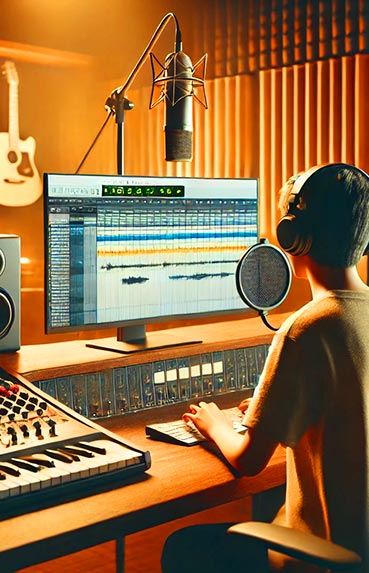Artificial Intelligence (AI) is transforming the way we interact with technology, and one of the fields most benefited by this evolution is virtual assistants. These programs have evolved from being simple tools for answering basic queries to becoming sophisticated personal assistants capable of performing complex tasks. Below, we will explore how AI is revolutionizing virtual assistants, the most notable innovations in this field, and how these improvements are affecting our daily lives.
The Evolution of Virtual Assistants
From Basic Tools to Sophisticated Companions
In their early days, virtual assistants like Siri, Alexa, and Google Assistant offered limited functions, mainly focused on answering basic questions and performing simple actions like setting alarms or playing music. However, with the advancement of AI, these assistants have evolved significantly.
Today, virtual assistants can understand and process natural language more accurately, allowing them to maintain more fluid and personalized conversations. Thanks to advances in natural language processing (NLP), assistants can interpret not just words, but also the context and intent behind them. This results in more natural and effective interactions.
Integration of Machine Learning
Machine learning has been a fundamental pillar in the evolution of virtual assistants. This approach allows systems to improve their responses and adapt to user preferences over time. For example, if a user tends to ask about the weather every morning, the assistant can anticipate this and provide the information without being prompted.
Machine learning enables virtual assistants to learn from every interaction, adjusting their algorithms to offer more accurate and useful responses. This not only enhances the user experience but also increases the assistant's efficiency in managing daily tasks.
Key Innovations in Virtual Assistants
Personalization and Contextualization
One of the most significant improvements driven by AI is the ability to personalize the user experience. Virtual assistants can now adapt their responses and suggestions based on individual user preferences and habits. This personalization goes beyond remembering names or music preferences; it involves a deeper understanding of the user's needs and desires.
For example, an assistant might suggest recipes based on available ingredients in the fridge or recommend optimized travel routes considering real-time traffic and user preferences.
Improved Voice Recognition
Voice recognition is a crucial feature of virtual assistants, and advancements in this area have been remarkable. AI has improved the ability of assistants to understand different accents and dialects, broadening their accessibility globally. Additionally, voice recognition technology has become more accurate, reducing errors and improving response speed.
A Microsoft study indicated that their systems' voice recognition has achieved 94% accuracy, approaching human-level performance. This improvement allows users to interact with their assistants more reliably and effectively.
Multitasking Capability
The ability to perform multiple tasks is another area where virtual assistants have experienced significant improvements. Advances in AI enable these systems to handle multiple requests simultaneously, increasing their usefulness in work and home environments.
For instance, an assistant can schedule a meeting, send an email, and control smart home devices, all at the same time. This multitasking capability transforms virtual assistants into indispensable tools for productivity.
Impact of AI on Daily Life
Enhancing Personal Productivity
With improvements in AI, virtual assistants have become essential allies for time management and personal productivity. By automating repetitive tasks and providing personalized reminders and alerts, these assistants help users optimize their time and focus on more important activities.
For example, assistants can organize schedules, send notifications about important deadlines, and suggest breaks based on the user's schedule, thereby improving efficiency and personal well-being.
Assistance in the Smart Home
Smart homes are a reality thanks to the integration of virtual assistants with IoT (Internet of Things) devices. AI allows these assistants to control lights, thermostats, security systems, and appliances, creating a more comfortable and efficient environment.
Home automation not only improves comfort but also contributes to energy efficiency by automatically adjusting lighting and temperature based on the presence of people in the home and weather conditions.
Accessibility and Assistance for People with Disabilities
AI has expanded the accessibility of virtual assistants, turning them into valuable tools for people with disabilities. Voice recognition and personalization capabilities allow users with physical or visual limitations to interact with technology more easily and effectively.
A report by the World Health Organization highlights how AI-based assistive technologies are transforming the lives of people with disabilities, enhancing their autonomy and quality of life.
Practical Tips to Make the Most of Virtual Assistants
Configuration and Personalization
To get the most out of a virtual assistant, it's essential to set it up properly and personalize it according to individual needs. Here are some practical steps:
- Review and update privacy settings: Ensure your virtual assistant is configured to respect your privacy and security preferences.
- Customize daily routines: Set up personalized routines to automate common tasks, such as turning on lights when arriving home or playing music at specific times.
- Train the assistant to improve accuracy: Some assistants offer the option to train their voice recognition, which can improve accuracy and efficiency.
Integration with Other Devices
Virtual assistants are more effective when integrated with other devices and services. Here are some suggestions to maximize this integration:
- Connect the assistant to smart home devices: Take advantage of remote control capabilities to manage lights, thermostats, and security systems.
- Integrate with productivity apps: Link the assistant to calendars, email apps, and task lists to improve organization and activity tracking.
Stay Updated
Virtual assistant technology is constantly evolving. To take advantage of the latest features and improvements, it's important to stay informed and updated:
- Regularly check for software updates: Ensure your device and virtual assistant are updated with the latest software versions.
- Explore new features and skills: Developers often release new features and skills for virtual assistants. Explore these options to discover how they can benefit your daily life.
In summary, artificial intelligence has taken virtual assistants to a new level of sophistication and utility. With improvements in personalization, voice recognition, and multitasking capabilities, these assistants have become indispensable tools for productivity and home management. By following practical tips and staying informed about the latest innovations, users can maximize the potential of their virtual assistants and enjoy a more efficient and connected life.

















